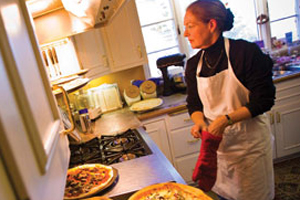Portrait of a Presidency
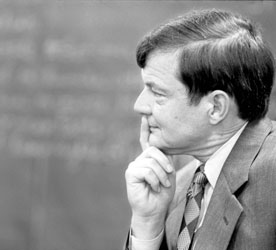
In 1997 Dennis Damon Moore was celebrating
10 years as the chief academic officer of
Cornell College. To commemorate this
milestone, President Leslie H. Garner Jr.,
who had only been at Cornell for about three
years, took to his wood shop. There he used
wood left over from the recent renovation of
Law Hall and shaped an old-fashioned springwound
clock for Moore.
“It is a beautiful object that keeps very good
time,” said Moore of the gift. “It should
continue to remain so for many years to come.”
“This,” he added, “is the story of Les Garner’s
presidency at Cornell College.”
Garner’s 15-year presidency has been a study in maintaining the best of the old
while innovating and improving the college. There’s hardly a corner of campus that
hasn’t been shaped, shined, and polished by the North Carolina native.
“It’s not the same college at all that he came into,” said Garner’s long-time
assistant Brinda Caldwell.
Indeed, Cornell has undergone astounding change in just 15 short years. A
larger faculty, new and innovative academic programs, stronger student life and
admission programs, improved alumni relations, a larger endowment, and, of
course, a plethora of new building and renovation projects have all marked the
Garner presidency to date.
“He had an ideal background, he had
the experience, a great academic
background, the personality, and a
great fit.”– Robert Slater ’60
After the previous president David Marker gave notice in March 1993 of his
resignation, the college created a search committee headed by Trustee Sherry Strong
and composed of trustees, faculty, students, alumni, and others. After an initial
search resulted in no hire by the February 1994 board meeting, Robert Slater ’60, a
search committee member and coincidentally one of the top executive recruiters in
the country, mapped out a route that not only found a strong fit for the college in
Garner, but found him in less than four months.
In May, the Board of Trustees voted unanimously for Garner, who at that time
was the president of North Carolina Wesleyan College. He was the first sitting
president ever to make the move to Cornell.
Garner and wife Katrina made an immediate impression.
“I was sort of starstruck from the first time I met Les and Katrina,” said Sue
Astley, a psychology professor who, along with Slater and Tom Jarom ’66, traveled
to meet the future president in North Carolina as part of the search.
Many felt that they were getting a package deal with the Garners.
“We felt like we had a home run with Les by himself,” said Jarom. “But with
Katrina it was a grand slam.” (More on Katrina Garner.)
On the day Garner was inaugurated, Jarom overheard two faculty members talking
as everyone gathered outside Old Sem for the procession to King Chapel. They
had just spotted Garner in his crimson robe representing his Ph.D. from Harvard.
As Jarom recalls it, one faculty member leaned over to the other and said,
simply, “Les Garner is what a college president should look like.”
“A president never stops worrying.”– Les Garner
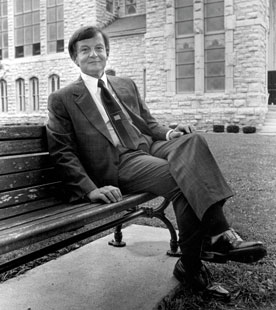
“There was so much to be done,” said Joan Claar, former vice president and dean of students, of Garner’s first years.
Garner stepped into a college that, in his words, had a lot going for it, but faced several challenges. For example, among Garner’s first acts was to institute a wage freeze, a necessity given the financial state of the college.
“This is not the way that a president would like to come into a college,” said Moore. However, he added, Garner’s openness with the faculty and staff, and insistence that the freeze would be reversed when possible, led to an atmosphere of trust between the college and its new president.
Garner also needed to make several key hires. Claar was the first, and started
the same day Garner took office.
Terry Gibson ’59 was next, filling out the President’s Council in the summer
of 1995. Gibson said he and Garner met and instantly hit it off. “Les was the
reason I came back,” he said.
The final addition to the Garner puzzle was Caldwell, who took over as
assistant to the president in 1995. She’s been in that position ever since.
That first year also brought with it challenges of retention, the student
experience, and changing demographics, all of which Garner took in stride.
“As he became part of the institution, he had more confidence in what
needed to be done and how to do it,” said Claar. But when asked how long it took
him to settle in, Claar answered, “About a day and a half. There was no choice.”
According to Jim Brown, special assistant to the president since 2005, one of
Garner’s first goals was to improve Cornell’s financial situation. Though the college
had just completed a successful $60 million campaign, Garner saw that if he wanted
to make certain improvements to the look of the campus, academic programs, or the
quality of the student experience, he would have to find even more money.
He started with the alumni. Cornell had benefitted over the years from the
generosity of Richard Small ’50 and his wife, honorary alumna Norma Small,
but Garner wanted to broaden the donor base and add new members to the
Board of Trustees.
The hiring of Gibson was the first major step, as he was able to fill the gap in
one of the few deficiencies on Garner’s resume: access to the untapped network of
Cornell alumni. Over the next few years, Gibson and Garner traveled extensively,
meeting with and recruiting alumni across the country. Slowly but surely, Garner
shaped the Board of Trustees that today is so instrumental to Cornell’s success.
“Les’ biggest contribution is the Board of Trustees,” said Gibson.
“Everybody’s involved.”
He added that, since Garner arrived, trustee giving has “exploded.”
“That’s his legacy, paying attention to the quality of the board,” added Glenn
Dodd, former vice president of business affairs and treasurer of the college.
It wasn’t just the trustees who responded to Garner. Giving among all alumni
has gone up during his tenure.
“He’s awoken a younger generation of alumni,” said Peter Wilch ’94, the
current vice president for alumni and college advancement.
The result is that the largest and most ambitious campaign in the college’s
history, the $92 million Extraordinary Opportunities Campaign, surpassed its
goal with months to go. The campaign will conclude in June 2010, but has already
raised more than $94 million.
“Even then when things were tough,
there was a real sense of purpose,
of direction.”– Peter Wilch ’94
From the mid-1980s till the late ’90s, Cornell experienced a surge in
enrollment, topping 1,000 students for the first time in its history, and remaining
steadily above 1,100 for much of that time. Enrollment looked to be a strong point
of the college during that time. Until the bottom fell out.
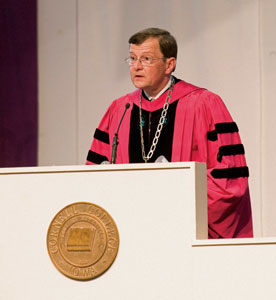
“I certainly had no notion that admissions would be a problem,” said Garner. “We had been blessed with extraordinary leadership in admissions.”
Peter Bryant had directed the boom of the mid-1980s, but his departure created stagnation in recruiting techniques.
“We learned that their extraordinary leadership had propelled us forward,” said Garner. “We were underinvested in admissions.”
To make matters worse, attrition rates were near 30 percent, nearly twice that of other Associated Colleges of the Midwest (ACM) institutions. As a result, enrollment dropped from 1,105 in 1996–97 to 965 by 1999–2000, the lowest the college had enrolled since the early ’80s.
“We had no margin for error,” said Garner. “To have an effective program, you
have to have a little insurance. You can’t work at the margins.”
Working first with Claar and later with current Vice President for Student
Affairs John Harp, Garner made it a point, starting with his 1996 Statement
of Strategic Intent, to enhance student retention. The effect was immediate, as
attrition dropped to less than 20 percent for first-year students in 1997–98. In
2006–07, attrition was as low as 15 percent. New student programs, a better sense
of community, enhanced career engagement, and improved residence halls all
impacted the rate at which students returned to Cornell.
Furthermore, the hiring of Stroud in 2002 gave admissions the direction it
needed to increase both applications and incoming classes. In 2003, enrollment
crossed 1,100 again, and, despite a recession and dropping enrollment around the
country, Cornell actually increased its student body population this year, up to
1,133. With a small graduating class, there is a real possibility that, in Garner’s 16th
year, Cornell will cross the 1,200 threshold for the first time.
“We have a real chance at 12–1300,” said Garner. “Then we face other
constraints like classroom and residence halls.”
“Those are nice problems to have to solve.”
“I would think it’s unprecedented. Show
me another 15-year period where this
much happened.”– John Harp
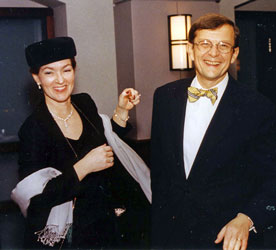
When Garner does retire eventually, he will leave one of the most significant physical footprints of any Cornell president. Numerous buildings and physical improvements, many important renovations, and quite a bit of landscaping will mark the Garner campus map. And it all starts with picking up trash.
According to Katrina, the physical appearance of the campus is very important to Garner. Every morning the two walk across campus and back, no matter what the weather, and during those walks Garner checks out the flowerbeds and picks up whatever trash he sees. “It’s a point of honor that we do this every morning,” said Katrina.
And every morning they walk past building after building Garner had a hand in making possible. His first major project was the renovation of Law Hall into a technology center. According to Garner, it was abundantly clear that technology would play an important role in higher education and that Cornell’s was nowhere near adequate.
And every morning they walk past building after building Garner had a hand in
making possible. His first major project was the renovation of Law Hall into a technology
center. According to Garner, it was abundantly clear that technology would play an
important role in higher education and that Cornell’s was nowhere near adequate.
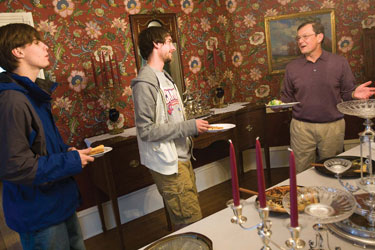
Thus, Garner set out to have Law Hall renovated and a campus-wide network created. In 1996 he created the office of computing services and established a new Information Technology Advisory Committee. In 2000 Law Hall was transformed into the Law Technology Center.
After upgrading Law Hall, Garner moved on to the fine arts, dedicating McWethy Hall in October 2002, and Youngker Hall and Kimmel Theatre in April 2003.
“You start, you build some momentum, and ideas come along,” said Garner.
And come they did. Merner Hall was renovated and reopened for the 2001–02 school year and New Hall and Clock Tower residence halls were opened in 2005 and 2007, respectively. Pfeiffer Hall renovation was completed in 2009, fulfilling Garner’s promise to improve the student experience through better residence halls. In the last 15 years, half of the bed spaces are new or newly renovated.
The changes were numerous in other areas of campus as well. The Marie
Fletcher Carter Pedestrian Mall opened up the central avenue of campus starting in
2002. Improvements were made to The Commons along the way, including a new
lounge outside the Ratt and a fitness center. Wade House became the Peter Paul
Luce Admission Center, and Rood House became the Paul K. Scott Alumni Center
after extensive renovations.
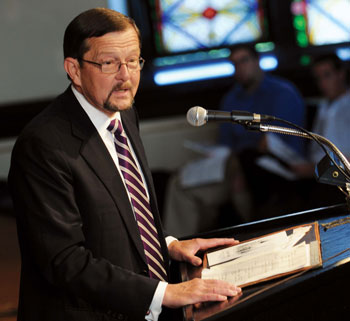
An educator at heart, some of Garner’s most fulfilling work has been developments in the academic programs. A cascade of new programs began when Larry Dorr ’63 first approached Garner with the idea for Dimensions: The Center for the Science and Culture of Healthcare, a unique interdisciplinary program whose primary purpose was to provide a liberal arts and OCAAT-worthy preparation for students looking to go into various medical fields.
“A president doesn’t have to have a lot of good ideas, but needs to be able to recognize them,” said Garner.
And recognize them he did. Shortly after Dimensions was founded by Dorr, Jim McWethy ’65 expressed interest in a business, economics, and public policy center in the same vein. With McWethy’s money to back it, the Berry Center for Economics, Business, and Public Policy was realized.
Faculty were involved in the process as well.
“He was not just off on his own. He did it in a way that faculty considered that they
felt involved and listened to,” said Chris Carlson, vice president of academic affairs and
dean of the college, and also a sociology professor at Cornell for nearly 30 years.
His responsiveness to faculty concerns has also resulted in a growing
environmental studies program bolstered by almost $1 million in funding over the
past year, a Center for Teaching and Learning with writing, qualitative reasoning,
and academic media studios, a Creative Writing Center in the planning stages,
and an expansion of the faculty he believes will continue as the college continues
to grow. The recent economic downturn has slowed the hiring of new faculty
somewhat, but new positions in the last few years were added to art history,
psychology, classics, theatre, biochemistry and molecular biology, and politics.
“It’s important for a college president
to have a good community profile.
Service is part of the college’s mission
and the president needs to lead by
example.”– Les Garner
In the summer of 2008 Cedar Rapids and Iowa City experienced the worst floods
in their history, displacing thousands and causing billions of dollars in damage. The
Hilltop was unaffected and was able to house displaced women and families, provide
beds for Red Cross volunteers, and gather donations for flood victims.
Harp said that when the first group contacted the college about a place to stay,
he knew others would follow. So, he turned to Garner for guidance.
“He just said very simply, ‘Do all you can with everything we have,’” said Harp.
“That’s the mantra I used.”
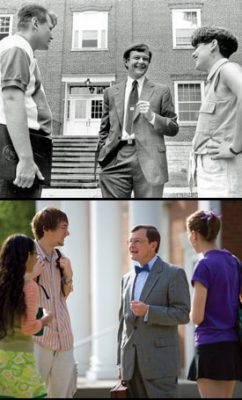
When Garner eventually departs Cornell one of his great legacies may be the services he provided and the sense of volunteerism that he brought to the college.
During his first several years Garner took on a number of civic responsibilities in the area—including serving on the boards of the Cedar Rapids Area Chamber of Commerce and the Cedar Rapids Symphony—and became very well known for it, according to Moore. Every year on service day, when new students and many Cornell staff do volunteer work throughout the community, Les and Katrina spend the day building, gutting, and digging along with everyone else.
“Les doesn’t do it for the accolades; he does it because it’s the right thing to do,” said Wilch.
“Part of it was that when I was in North Carolina, civic leadership was important,” said Garner. “Also I happen to like doing it.”
It has also been the right thing for the college. As Garner has gained seniority as a sitting president among peer colleges, he has been named to serve as the chair or president of the National Association of Independent Colleges and Universities, the Iowa College Foundation, the Associated Colleges of the Midwest, and the Iowa Association of Independent Colleges. His service has led to a higher visibility for Cornell.
“People will look at Les Garner and
say that was one of the great times in
Cornell’s history.”– Peter Wilch
Garner has no plans to leave Cornell. Elbow deep in efforts to renovate
The Commons, King Chapel, and West Science, and intently focused on raising
enrollment above 1,200, not to mention the effects of a recession, Garner has
plenty to keep him busy in the coming years. His vision is to secure Cornell’s
standing through growth, a distinctive position in the market, and active student
engagement. With 15 years and the momentum of the college carrying his vision
forward, his many goals seem more attainable than ever.
“I said upon my retirement that Cornell had probably never had a better
president and never would. I thought that Les was as good as it gets,” said Moore.
“This is the story of Les Garner’s presidency at Cornell College,” he added,
recalling the gift he received for his 10th year. “The clock he made was his wonderful
gift to me; the Cornell College he has been making—which will, of course, need its
own version of winding in the future—will be his wonderful gift to all of us.”


